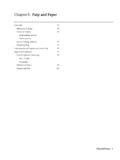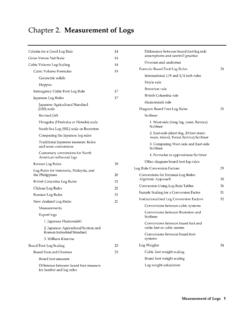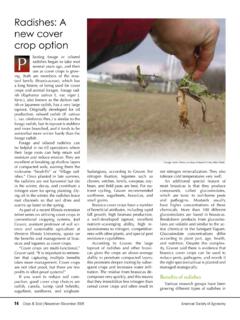Transcription of Chapter 7. Chips, Sawdust, Planer Shavings, Bark, and Hog Fuel
1 83 Expansion Factors, Relative Solid Volume, and compaction 84 Expansion (Fluffing) Factor 84 Loose expansion factor Compacted expansion factor Relative Solid Volume 84 compaction 84 compaction ratio compaction percent Summary 85 Bulk Density 85 Oven-dry Bulk Density 85 Wet Bulk Density 85 Effect of Drying (Shrinkage) on Bulk Density 87 Summary 87 Units of Residue Measure and Conversions 87 The 200 Cubic Foot Volumetric Unit 87 Weight Measures 90 Stowage Factor and compaction in Shipping 91 Stowage factor compaction percent Residue Yield 91 Sawdust91 Pulp Chips 91 Planer Shavings 91 Bark 91 Hog Fuel 93 Residue Calculation Examples 93 Estimating Yield from Plywood 93 Estimating Yield per Cunit of Log Input 93 Converting Units of Residue to Weight 93 Estimating a Hog Fuel Mix 94 Chapter 7.
2 Chips, Sawdust, Planer Shavings, Bark, and Hog Fuel Chips3 Chapter 7. Chips, Sawdust, Planer Shavings, Bark, and Hog Fuel Previous chapters have presented material balances that can be used to estimate the fraction of a log recovered in a residue form. There are many factors that affect chip and residue measures and associated conversion factors. These include: Size and geometry: The differences in physical characteristics of these residues are obvious and affect how they occupy a unit of space. Specific gravity: Wood and bark densities differ between species (Tables 1-1, 7-5). Moisture content: Wood and bark moisture contents vary between species (Table 1-1), and water may be added during pond storage and debarking. Buyers and sellers of residues and statistical reporting organizations generally devise some method for correcting to the oven-dry state.
3 Degree of compaction : Over time, chips and residues will settle due to gravity. Also, mechanical and pneumatic compaction can be used to pack more residue into a given space. Quantities of chips and residues are measured in units of volume or weight. This Chapter discusses volumetric expansion factors and bulk densities for these products, typical units of measure and conversion, and residue yields, and also presents examples that integrate this material. Expansion Factors, Relative Solid Volume, and compaction To illustrate these terms, consider a log con-taining 5 cubic feet of solid wood (Vsw) that is chipped. Obviously, the chips will occupy more space than 5 cubic feet. Expansion (Fluffing) Factor Loose Expansion Factor. Immediately after chipping, suppose the loose chips occupy 15 cubic feet (Vp). The expansion factor (E), also called thefluffing factor, is E (loose) = Vp / Vsw = 15 ft3 / 5 ft3 = Note that when Vsw and Vp are measured in cubic meters, the expansion factor has the same value.
4 Compacted Expansion chips will settle over time due to gravity, or they may be physically compacted by equipment. Suppose the chips are compacted so the space occupied (Vp) reduces to 12 cubic feet. The expansion factor is E (compacted) = 12 ft3 / 5 ft3= These calculations illustrate the importance of noting the degree of compaction associated with a particular expansion factor. Measures of compaction are discussed below. Relative Solid Volume The reciprocal of the expansion factor measures the number of solid cubic feet (cubic meters) that will yield a cubic foot (cubic meter) of residue. Continuing the example, relative solid volume (RSV), also termed volume occupancy, is RSV (loose) = 1 / E (loose) = 1 / 3. 00 = RSV (compacted) = 1 / E (compacted) = 1 / = Some multiply RSV by 100 to express it as a percentage; in this form it is sometimes called a compaction Ratio.
5 A common measure of com-paction is the compaction ratio (CR), which is CR = Vp (loose) / Vp (compacted) = 15 ft3 / 12 ft3 = CR = E (loose) / E (compacted) = / = CR can also be calculated from the relative solid volumes. It has a value of one for loose residue and increases as the particles become more compacted. A maximum value for CR can be estimated if it is assumed that the maximum compaction possible would compress the residue to the original volume of solid wood. Under these conditions: Vp (compacted) = Vsw hence CR = 15 ft3 / 5 ft3= 4 Chapter 7 In other words, the limiting value of the compaction ratio is numerically equal to the expansion factor for loose particles. compaction Percent. A less common compaction value can be obtained from volume changes. From the example, the maximum compaction from loose chips to solid wood is 10 cubic feet, while the actual compaction is 3 cubic feet.
6 Actual compaction as a percentage of the maximum possible is compaction % = 100 * [Vp (loose) Vp (compacted)] / [Vp (loose) Vsw] = 100 * (15 12) / (15 5) = 30%. Summary Table 7-1 presents expansion factors for various types of residues and corresponding relative solid volumes. Also shown are conversions from Imperial to metric and equivalents when residues are meas-ured in 200 cubic feet volumetric units (see p. 87). Tables 7-2 and 7-3 present additional sources of expansion factor and compaction ratios. The con-version methods applied to the expansion factors in Table 7-1 can also be applied to the expansion factors presented in Table 7-2. Bulk Density Bulk density (BD) refers to residue weight divided by residue volume. Suppose the example log has a moisture content of 80% MCod ( MCw) and specific gravity (SGg) is (see Chapter 1 for definitions).
7 Using methods presented in Chapter 1, wood density is wet pounds per green cubic foot. This is composed of lb of oven-dry wood plus lb of water. The term basicdensity is sometimes used to refer to the oven-dry weight per cubic foot ( , lb/ft3). The chips from the 5 cubic-foot log have the following weight distribution: ConditionWeight (lb)Percent Oven-dry wood (Wod) Water (MCw) Wood + water (Wwet) The term solids fraction refers to the percent- age of total weight that is oven-dry wood. As was described for solid wood density in Chapter 1, bulk density can be calculated for any combination of numerator (weight) and denomi-nator (volume) moisture contents, hence it is important to specify these conditions. The more common cases are given in the remainder of this Bulk DensityThis is the oven-dry weight per green cubic footof residue.
8 Divide the weight of oven-dry wood (Wod) by the residue volume (Vp) BDod (loose) = Wod / Vp (loose) = lb / 15 ft3 = BDod (compacted) = Wod / Vp (compacted) = lb / 12 ft3 = The same results can also be obtained by dividing the basic density ( lb/ft3) by the appropriate expansion factor. These bulk densities indicate the amount of oven-dry wood present in each loose or compacted greencubic foot of residue. They are important in residue transactions because purchasers wish to pay only for wood and therefore want the weight of water excluded. The residue volume is green, since these are undried chips fresh from the log. In cases where residues are dried or manufactured from dry wood, these bulk densities would change because wood shrinkage will modify the volume the residue occupies. This will be illustrated below.
9 Wet Bulk Density Bulk density can also be calculated with the moisture content included in the weight (total weight per green cubic foot of residue): BDwet (loose) = Wwet / Vp (loose) = ( lb / 15 ft3) = BDwet (compacted) = Wwet / Vp (compacted) = ( lb / 12 ft3) = The same results can also be obtained by dividing the wet wood density ( lb/ft3) by the appropriate expansion factor. These values areChips56 Chapter 7 useful for estimating actual weights and loadings on equipment. For the same compaction , knowledge of moisture content allows conversion between BDodand BDwet: BDwet = BDod* (1 + MCod / 100). Effect of Drying (Shrinkage) on Bulk Density Bulk densities of dry residues or residues manufactured from dry wood will differ from those in the preceding example. One reason is that the type of residue may be different.
10 Examples are Planer shavings and sander dust obtained when kiln-dried wood is surfaced; these residue forms may have different expansion factors. Another reason is that because wood shrinks as it dries, the residue occupies less space. Since many secondary wood products industries, such as millwork and furniture, utilize dry wood, their oven-dry bulk densities will be higher and their wet bulk densities will be lower due to the effects of shrinkage and lower moisture content. See Example 1. SummaryThis section has demonstrated how various factors affect bulk density calculations. Tables 7-2 and 7-3 present data illustrating the influence of mill source (residue type) and species on bulk densities. It should be obvious from the discussion that bulk density is ambiguous without clear statement of the species (wood specific gravity), type of residue, degree of compaction , and the moisture content of both the numerator and denominator.




